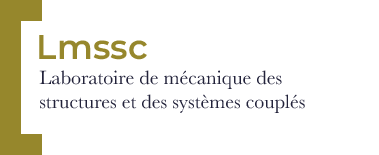Analogous piezoelectric networks for the design of highly damped metastructures
Résumé
When dealing with thin and lightweight structures, as in aerospace systems, most of the materials offering a good stiffness-to-density ratio have very low intrinsic damping properties. At the level of the whole structure, this generates weakly damped mechanical modes, which can be critical because they often lead to high amplitude vibrations. Such structural vibrations can be reduced by employing piezoelectric material as passive electromechanical transducers able to convert the vibration energy into electrical energy. This concept is behind piezoelectric shunt damping, which consists in connecting a one-port electrical circuit to a piezoelectric transducer for impedance matching and thus optimized energy transfers. Using passive components such as resistors, inductors or capacitors leads to autonomous and inherently stable control solutions. Inductance in the circuit creates an electrical resonance due to the charge exchange with the piezoelectric capacitance. In this case, impedance matching consists in tuning the resonance of the shunt to a natural frequency of the mechanical structure. The equivalent of a tuned mass damper is thus implemented with a vibration absorber that is designed as the electrical counterpart of the mechanical resonance to be controlled. This uni-modal case introduces the interest of electrical analogues for piezoelectric damping.
Analogous coupling can actually be extended to broadband vibration mitigation. A multi-resonant electrical network is then required to approximate the modal properties of the mechanical structure. On one hand, the electrical network should exhibit similar modal distributions. Such a spatial coherence condition is met by discretizing the constitutive equations of the continuous mechanical medium, applying an electromechanical analogy, and deriving the electrical connections which are analogous to the considered mechanical boundary conditions. On the other hand, the structure and the developed network should have similar wave propagation properties to meet a frequency coherence condition. Hence, a passive broadband damping can be achieved by coupling a structure to its analogous electrical network. This method was applied to the damping of basic structures such as bars, beams, curved beams and plates. Both numerical and experimental results validate the concept of analogous piezoelectric damping. Application to more complicated geometries can however become difficult when moving away from an assembly of the previously listed simple structures. Furthermore, the method requires a sufficiently fine discretization of the electrical network which often results in a lot of electrical components. More recent techniques introduce modal-based synthesis of multi-port circuits, which reduces the size of the electrical networks to a minimum and thus offers better applicability to complex industrial structures.

